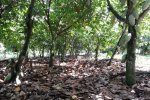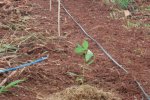
Project
Pruning in Cocoa
We aim understand and quantify cocoa response to pruning in relation to shading and to design optimal pruning practices tailored for the specific agronomical condition of West Africa using a combined experimental and modelling approach.
Millions of small holder farmers in West Africa produce 73% of the global cocoa production. The majority of cocoa is produced in agroforestry systems with shade trees and low input of nutrients. In addition, cocoa stands are often poorly managed, with little attention to maintenance and pruning. As a result, realized yields are far those that can be potentially reached in the region.
Pruning improves vegetation growth and production in tree crops as it optimizes the balance of vegetative and reproductive growth and increases the efficacy of fertilization and pest control. However, current pruning practices in cocoa are minimal and recommended practices lack scientific support. Pruning has deep effects on plant functioning and assimilate partitioning, which are expected to strongly interact with the level of shading. These effects crucially determine yield but have not been quantified so far.
My objective is to understand and quantify cocoa response to pruning in relation to shading and to design optimal pruning practices tailored for the specific agronomical condition of West Africa.
A combined experimental and modelling approach will be used to address my objectives. Pruning experiments will be conducted on juvenile and adult plants to quantify local responses in resources allocation. A simulation model of the cocoa plant will be developed that explicitly simulates the plant architecture and the effects of pruning and shading. Experimental data gathered in trials in West-Africa will be used for model calibration and evaluation. Scenarios studies will done to individuate optimal practises under different shade and climatic conditions.
Pruning improves vegetation growth and production in tree crops as it optimizes the balance of vegetative and reproductive growth and increases the efficacy of fertilization and pest control. However, current pruning practices in cocoa are minimal and recommended practices lack scientific support. Pruning has deep effects on plant functioning and assimilate partitioning, which are expected to strongly interact with the level of shading. These effects crucially determine yield but have not been quantified so far.
My objective is to understand and quantify cocoa response to pruning in relation to shading and to design optimal pruning practices tailored for the specific agronomical condition of West Africa.
A combined experimental and modelling approach will be used to address my objectives. Pruning experiments will be conducted on juvenile and adult plants to quantify local responses in resources allocation. A simulation model of the cocoa plant will be developed that explicitly simulates the plant architecture and the effects of pruning and shading. Experimental data gathered in trials in West-Africa will be used for model calibration and evaluation. Scenarios studies will done to individuate optimal practises under different shade and climatic conditions.

